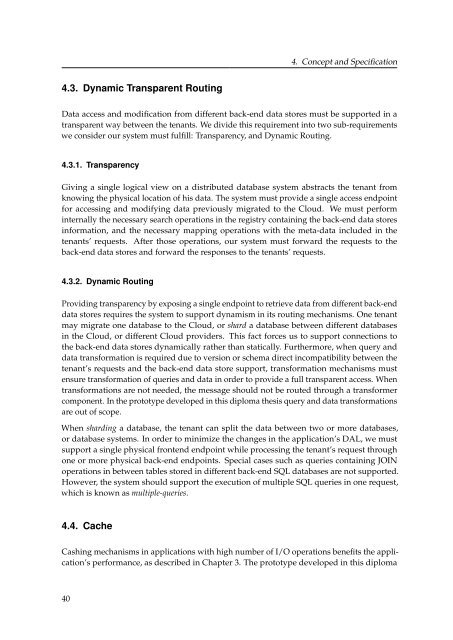Diploma Thesis Santiago Gómez Sáez - IAAS
Diploma Thesis Santiago Gómez Sáez - IAAS
Diploma Thesis Santiago Gómez Sáez - IAAS
You also want an ePaper? Increase the reach of your titles
YUMPU automatically turns print PDFs into web optimized ePapers that Google loves.
4. Concept and Specification<br />
4.3. Dynamic Transparent Routing<br />
Data access and modification from different back-end data stores must be supported in a<br />
transparent way between the tenants. We divide this requirement into two sub-requirements<br />
we consider our system must fulfill: Transparency, and Dynamic Routing.<br />
4.3.1. Transparency<br />
Giving a single logical view on a distributed database system abstracts the tenant from<br />
knowing the physical location of his data. The system must provide a single access endpoint<br />
for accessing and modifying data previously migrated to the Cloud. We must perform<br />
internally the necessary search operations in the registry containing the back-end data stores<br />
information, and the necessary mapping operations with the meta-data included in the<br />
tenants’ requests. After those operations, our system must forward the requests to the<br />
back-end data stores and forward the responses to the tenants’ requests.<br />
4.3.2. Dynamic Routing<br />
Providing transparency by exposing a single endpoint to retrieve data from different back-end<br />
data stores requires the system to support dynamism in its routing mechanisms. One tenant<br />
may migrate one database to the Cloud, or shard a database between different databases<br />
in the Cloud, or different Cloud providers. This fact forces us to support connections to<br />
the back-end data stores dynamically rather than statically. Furthermore, when query and<br />
data transformation is required due to version or schema direct incompatibility between the<br />
tenant’s requests and the back-end data store support, transformation mechanisms must<br />
ensure transformation of queries and data in order to provide a full transparent access. When<br />
transformations are not needed, the message should not be routed through a transformer<br />
component. In the prototype developed in this diploma thesis query and data transformations<br />
are out of scope.<br />
When sharding a database, the tenant can split the data between two or more databases,<br />
or database systems. In order to minimize the changes in the application’s DAL, we must<br />
support a single physical frontend endpoint while processing the tenant’s request through<br />
one or more physical back-end endpoints. Special cases such as queries containing JOIN<br />
operations in between tables stored in different back-end SQL databases are not supported.<br />
However, the system should support the execution of multiple SQL queries in one request,<br />
which is known as multiple-queries.<br />
4.4. Cache<br />
Cashing mechanisms in applications with high number of I/O operations benefits the application’s<br />
performance, as described in Chapter 3. The prototype developed in this diploma<br />
40

















